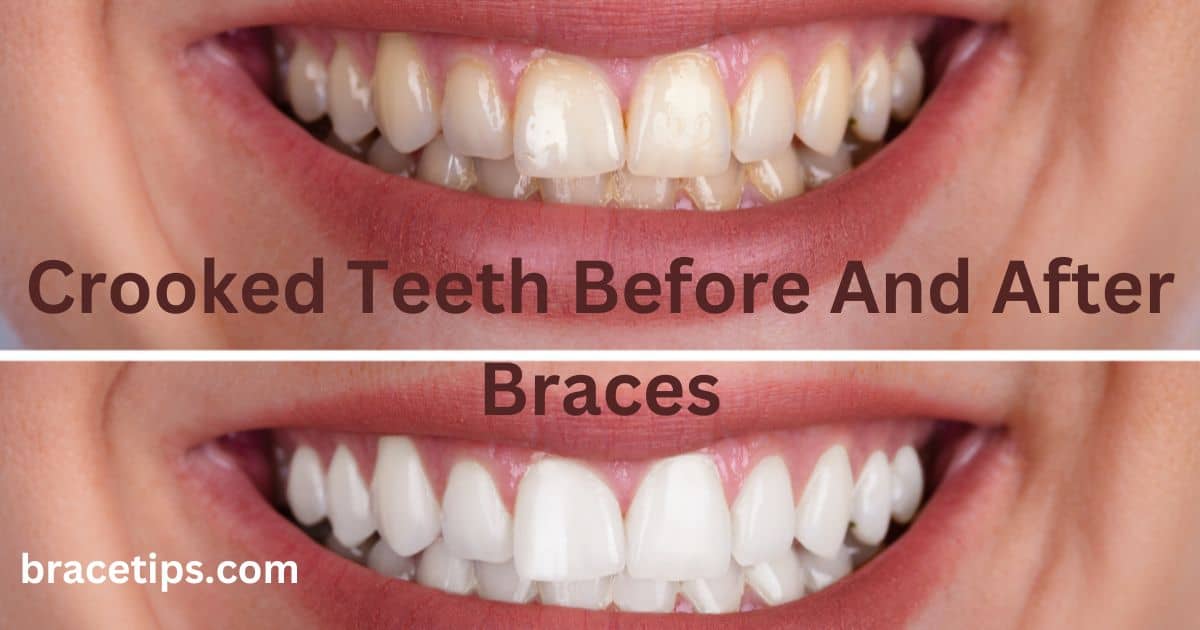Crooked Teeth Before And After Braces
Crooked teeth, while a common dental concern, can significantly impact one’s confidence and oral health. We will delve into the transformative journey of individuals who have undergone orthodontic treatment, exploring the process before and after braces. Crooked teeth can impact not only one’s oral health but also their confidence and self-esteem. Thankfully, the advent of orthodontic treatments, particularly braces, has revolutionized the way we approach dental alignment issues. This article explores the profound transformation that occurs with crooked teeth before and after braces, delving into the process, benefits, and frequently asked questions surrounding this life-changing journey. Orthodontic treatments like braces offer effective solutions for aligning teeth and achieving a straighter, healthier smile. In this comprehensive guide, we’ll delve into the journey of individuals with crooked teeth before and after braces, exploring the process, benefits, and frequently asked questions surrounding this transformative orthodontic treatment.
What Causes Crooked Teeth?
Crooked teeth can result from various factors, including genetics, overcrowding, jaw irregularities, and childhood habits such as thumb-sucking or tongue thrusting. The root causes is crucial in devising an effective treatment plan.
Best Impact of Crooked Teeth on Oral Health
Beyond cosmetic concerns, crooked teeth can contribute to oral health issues, such as difficulty in proper cleaning, increased risk of gum disease, and uneven wear on teeth. Exploring these consequences provides insight into the importance of seeking orthodontic intervention.
How Braces Work?
Braces are orthodontic devices designed to gradually shift teeth into proper alignment. This section breaks down the mechanics behind braces, detailing the role of brackets, wires, and adjustments in the transformative process.
Different Types of Braces
From traditional metal braces to modern alternatives like clear aligners, the market offers a variety of options. A comprehensive overview of each type, including their pros and cons, helps individuals make informed decisions based on their preferences and needs.
Before and After Braces – A Visual Journey
Before Braces, The Initial Assessment
The first step in the transformation journey involves a thorough examination by an orthodontist. This includes X-rays, impressions, and discussions about treatment goals. This section provides a detailed account of what individuals can expect during their initial assessment.
During Braces, The Transformational Process
Tracking the progress during the braces-wearing period is essential. Explore the various stages, potential challenges, and tips for maintaining oral hygiene and comfort throughout the treatment.
After Braces, Reveling in the Results
The unveiling of the final results is a moment of joy for individuals who undergo orthodontic treatment. Share success stories, discuss the significance of retention appliances, and provide insights into maintaining the newfound smile.
Crooked teeth, also known as malocclusion, occur due to various factors such as genetics, jaw size discrepancies, childhood habits like thumb sucking, or early loss of baby teeth. Beyond aesthetic concerns, crooked teeth may lead to difficulties in chewing, speaking, and maintaining oral hygiene.
The Braces Experience: Before, During, and After
Before Braces: Evaluation and Consultation
Before embarking on the braces journey, individuals undergo a comprehensive evaluation by an orthodontist. This involves examining the teeth, jaw, and bite alignment through visual inspection, X-rays, and molds. The orthodontist then formulates a personalized treatment plan tailored to address the specific concerns and goals of the patient.
During Braces: The Treatment Process
The braces application process typically begins with thoroughly cleaning and drying the teeth to ensure optimal adhesion. Next, the orthodontist attaches brackets to each tooth using dental adhesive and secures them in place with archwires. These wires apply gentle pressure to gradually shift the teeth into their desired positions. Over time, periodic adjustments are made to the braces to maintain progress and achieve optimal alignment.
After Braces: Retention and Maintenance
Once the desired results are achieved, the braces are removed, unveiling a beautifully aligned smile. However, the journey doesn’t end there. To prevent relapse, retainers are prescribed to maintain the new tooth positions while the surrounding bone and tissues adapt. It’s crucial for individuals to adhere to their orthodontist’s instructions regarding retainer wear and follow-up appointments to ensure long-term success.
Benefits of Braces, Beyond Aesthetics
Improved Oral Health
Straightening crooked teeth with braces not only enhances the appearance of the smile but also promotes better oral health. Additionally, correcting bite issues can alleviate strain on the jaw joints and muscles, reducing the likelihood of temporomandibular joint (TMJ) disorders.
Enhanced Self-Confidence
The psychological impact of having crooked teeth can take a toll on self-esteem and confidence. By transforming their smile with braces, individuals experience a boost in self-confidence and self-image. They no longer feel self-conscious about their teeth and are more comfortable smiling, speaking, and interacting with others in social and professional settings.
Functional Benefits
In addition to cosmetic improvements, braces can also enhance the functionality of the teeth and jaw. Correcting misalignments and bite issues can improve chewing efficiency, speech clarity, and overall oral function. This not only contributes to better oral health but also enhances quality of life by reducing discomfort and improving overall well-being.
Importance of addressing crooked teeth
- Aesthetic concerns: The impact of a confident smile on personal and professional aspects.
- Oral health implications: Addressing the risk of dental issues associated with misaligned teeth.
Overview of braces as a solution
Understanding the variety of braces available and the factors influencing candidacy.
- Different types of braces: Traditional metal braces, clear aligners, and lingual braces.
- Candidacy for braces: Assessing the suitability of orthodontic treatment.
Before getting braces
Exploring the causes of crooked teeth and dispelling common misconceptions.
- Causes of crooked teeth: Genetic factors, habits, and developmental issues.
- Common misconceptions: Debunking myths surrounding orthodontic treatment.
Consultation and assessment
The crucial steps before embarking on the braces journey.
- Visiting an orthodontist: Importance of professional guidance.
- X-rays and examination: Gathering essential information for personalized treatment plans.
Types of braces available
Comparing the options to help individuals make informed decisions.
- Traditional metal braces: Time-tested and effective.
- Clear aligners: Invisible and removable.
- Lingual braces: Concealed behind the teeth.
The process of getting braces
Insight into the fitting process, adjustments, and maintenance.
- Fitting and adjustments: Customizing braces for individual needs.
- Maintenance and care: Ensuring optimal oral hygiene during treatment.
Challenges during the braces journey
Addressing common concerns individuals may face during orthodontic treatment.
- Discomfort and soreness: Managing pain with orthodontic wax and pain relievers.
- Dietary restrictions: Foods to avoid and maintain braces integrity.
Transformative journey
Tracking progress and experiencing positive changes in oral health.
- Tracking progress: Regular check-ups and adjustments.
- Positive changes in oral health: Addressing bite issues and improved hygiene.
After braces, The big reveal
Understanding post-treatment care and maintaining the results.
- Retainers and post-treatment care: Securing the achieved alignment.
- Maintaining results: Oral hygiene practices and follow-up appointments.
Real-life transformations
Highlighting personal testimonials and the impact on self-esteem.
- Personal testimonials: Sharing experiences of individuals who transformed their smiles.
- Impact on self-esteem: Boosting confidence and overall well-being.
Addressing common concerns
Providing clarity on frequently asked questions regarding braces.
- Affordability of braces: Exploring financial options and insurance coverage.
- Duration of treatment: Understanding the factors influencing the timeline.
Call-to-action
Embark on your transformative journey today. Consult with an orthodontist to discover the possibilities of achieving a radiant, straight smile.
Cost of Braces
Orthodontic treatment comes with a financial aspect. Break down the costs involved, including initial consultations, braces types, and potential additional expenses. Discussing insurance coverage and financing options enhances transparency for readers.
Benefits Beyond Aesthetics
While improved aesthetics are a primary motivator, delve into the additional benefits of braces, such as enhanced oral health, reduced risk of dental issues, and improved overall well-being.
FAQ Section
Q: Are braces only for cosmetic purposes?
A: No, braces address both aesthetic concerns and contribute to improved oral health.
Q: How long does the braces treatment typically take?
A: The duration varies, but the average treatment time is around 18-24 months.
Q: Are there alternatives to traditional metal braces?
A: Yes, alternatives include clear aligners and lingual braces, offering discreet options.
Q: Do braces hurt, and how can discomfort be managed?
A: Initially, braces may cause discomfort, but orthodontic wax and pain relievers can help manage it.
Q: What is the importance of retainers after braces?
A: Retainers help maintain the achieved alignment and prevent relapse.
Q: How Long Does the Braces Process Take?
A: The timeline of orthodontic treatment is crucial for managing expectations. Detailing the average duration and factors influencing treatment duration contributes to a realistic outlook.
Q: Does the Braces Process Hurt?
A: Addressing common concerns about pain and discomfort during and after braces helps alleviate anxieties. Explain the role of adjustments, wax, and over-the-counter pain relief in managing potential discomfort.
Q: Can Adults Get Braces?
A: Many adults hesitate to seek orthodontic treatment due to misconceptions. This section busts myths, discusses the rising trend of adult orthodontics, and highlights the benefits of pursuing braces later in life.
Conclusion
The journey from crooked teeth to a confident smile through braces is transformative. The investment in orthodontic treatment goes beyond aesthetics, positively impacting oral health and self-esteem. Crooked teeth before and after braces represent a transformative journey that extends beyond cosmetic improvements. By providing comprehensive information on the causes, impact, and solutions for crooked teeth, this article aims to empower individuals to make informed decisions about their orthodontic journey. Emphasizing the life-changing effects of braces ensures readers understand the value of seeking orthodontic intervention for a healthier, more confident smile.

